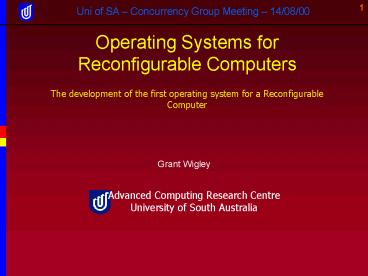Operating Systems for Reconfigurable Computers - PowerPoint PPT Presentation
1 / 21
Title:
Operating Systems for Reconfigurable Computers
Description:
Why multitask a RC and why use an operating system (OS) ... Multitasking an FPGA will require an OS to manage the loading, swapping and ... – PowerPoint PPT presentation
Number of Views:40
Avg rating:3.0/5.0
Title: Operating Systems for Reconfigurable Computers
1
Operating Systems for Reconfigurable Computers
The development of the first operating system for
a Reconfigurable Computer
Grant Wigley
Advanced Computing Research Centre University of
South Australia
2
Overview
- What is a Reconfigurable Computer (RC)?
- Why multitask a RC and why use an operating
system (OS)? - What are the major design stages in creating FPGA
designs and why incorporate them into the OS? - The OSs specific algorithms
- Future Work
3
A Reconfigurable Computer
- Include reconfigurable logic, currently
Field-Programmable Gate Array (FPGA) technology,
as part of the processing resource - Speed up computations by implementing algorithms
as circuits, thereby eliminating fetch and decode
cycles and exploiting concurrency
4
Example SPACE.2 System
- PCI Bus based co-processing board
- Alpha UNIX host
- Controlled via device driver
- Array of XC6200 FPGAs
Inter-board network on secondary backplane
Computing surface 8 x XC6200 FPGAs
Clock module
Buffer RAM module
Control logic module
SPACE.2 board
64 bit PCI local bus on host motherboard
5
Reconfigurable Computing
- For RC to become mainstream then it must have
appropriate OS support - As the number of gates rapidly increases the
efficiency of area becomes less important than it
was - The wasted area due to the OS can be traded for
an increase in ease of use of the RC
6
Multitasking an FPGA??
- With the development of the partially
reconfigurable FPGA, designers are looking
towards multitasking Reconfigurable Computers - Multitasking a RC will have the ability to
concurrently execute more than one dependent or
independent task thus increasing the RC
throughput and reducing the average waiting time
7
Why an OS for RC?
- Multitasking an FPGA will require an OS to manage
the loading, swapping and allocation of the tasks
to the FPGA surface - As the status of the FPGA changes in time, the
designs will have to be completed at run-time,
and not statically compiled - This requires the partitioning, placement and
routing to be handled by the OS
8
Problems with Run-time Design
- The partitioning, placement and routing
algorithms are NP-hard and require long execution
times and if the system is to be online these
choices have to be made as quick as possible - Difficult for an automatic process to make design
decisions for logic circuits and get it right all
of the time
9
The Design Stages
- Allocation
- Deciding which part of the FPGA is available and
can accommodate the incoming task
FPGA
FPGA
Incoming task
Available Space
10
Dynamic Partitioning
- Deciding how to fit a task graph to the available
hardware
Circuit Design
11
Placement
- What nodes of the design get mapped to what FPGA
cells?
3
2
4
1
5
3
6
5
1
4
6
2
Allocated, Partitioned Circuit
FPGA partition
12
Routing
- Determining a path between two points to create
an electrical connection
B
A
13
The Implementation Details
- Based on the Client/Server model
- Assumes 2-input lookup table
- X lines of C code
- Compiled under gcc, using Linux 6.2 OS running on
a 433 Mhz Celeron Laptop
14
General Specifics
- Uses sockets and ports for connectivity
- Can accept any number of clients
- 3 - digit protocol for communication
- Host password file for security
15
Uploading a User Circuit
- File Format
- User sends the file to the server and the server
caches it until the user leaves
5 1 1 2 3 2 1 3 5 3 1 1 0 4 1 3 5 5 1 0 0
Total no. of nodes
Node connection Number
Node Number
Size of node
16
Allocation Algorithm
- Stores the file into a linked list structure
- Calculates the total area required for the design
and determines the optimal circuit dimensions
(the OS limits it to rectangles) - Determines if there is available FPGA logic
- If the circuit is unable to be placed in its
current shape it calculates the largest FPGA
logic area available
17
Dynamic Partitioning Algorithm
- The algorithm is based on the Temporal
Partitioning Algorithm by Gajjala Purna - Calculates the As Soon As Possible (ASAP)
execution levels of each node - Allocates the nodes in order of ASAP level to the
partition until the partition is full
18
The Partitioning Algorithm
- ASAP Leveling
- Queue 0
- For each node
- If Indegree 0
- Level 1
- Queue.Add
- End If
- End For
- While Queue is not empty do
- For each Fanout
- Indegree--
- If Indegree 0 then
- Level(I) Level (I-1) 1
- Queue.Add
- Endif
- End For
- End While
Level-Based Partitioning j 0 While level lt
max_level for each node with level
node.level total_cost node.size RCOST
if((area_filled total_cost)lt freespace
node.partition j area_filled
area_filled total_cost else j
area_filled total_cost Endif
Endfor Endwhile
19
Placement Algorithm
- Constructive Deterministic placement
- Places the first node to the right of the parent
- Places the second node on top of the parent
- Similar to what COOL does
20
Future work
- To think up a sexy name!
- Testing the system with the ISPD98 Benchmark
suite - Complete a 2 stage router
- Methods for handling inter- partition
communication - Possible developed for use with real circuit
formats (XNF, Netlist)
21
Conclusion
- For FPGAs to become mainstream an appropriate OS
must be developed - Willing to trade the lose in performance for an
increase in ease of use - The OS will integrate all of the run-time design
procedures






























